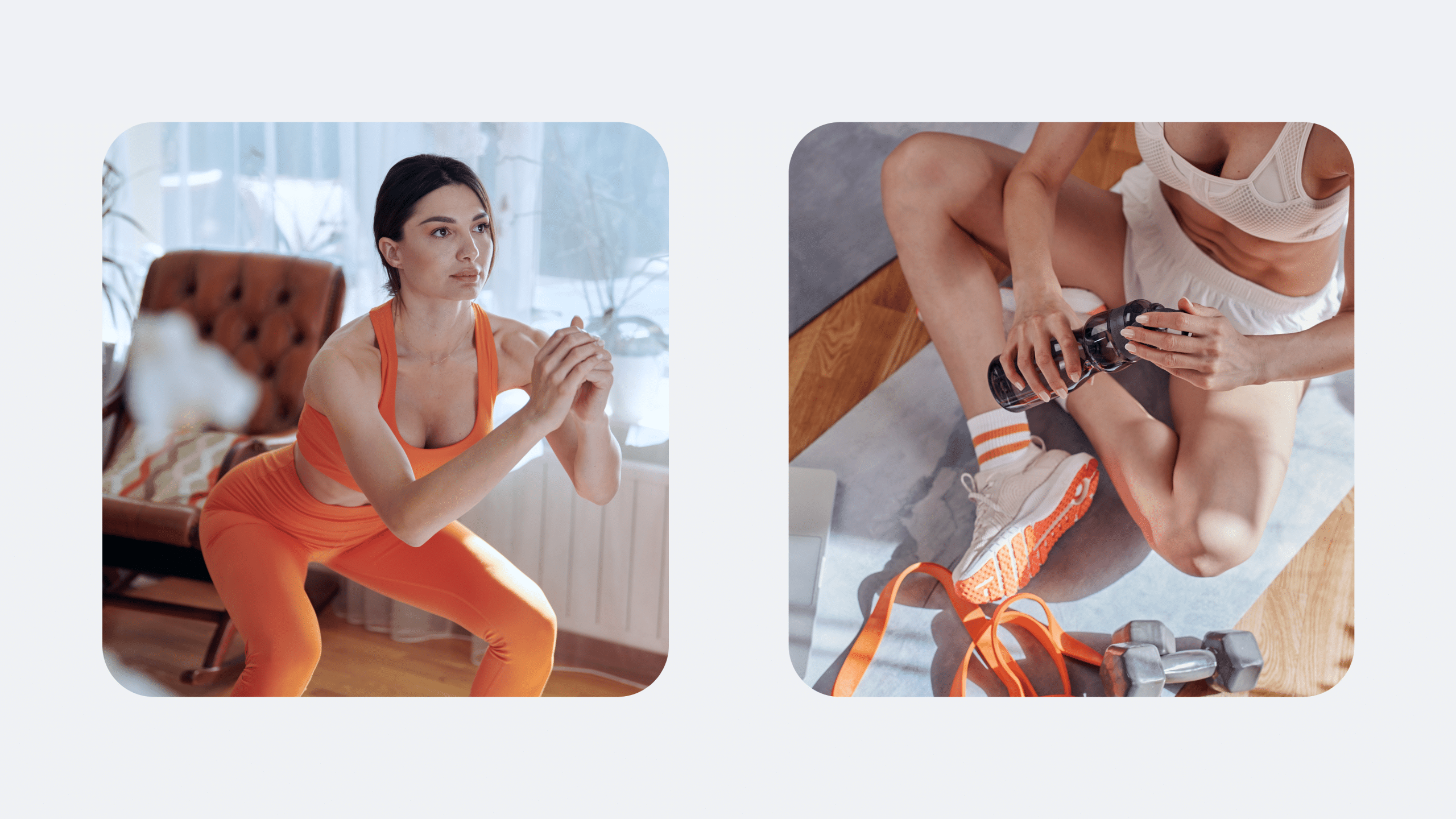Getting time to exercise can be a real challenge. For those juggling a full-time job, family responsibilities, or an active social life, it may seem like there’s just no room for consistent fitness.
But it doesn’t have to be that way. In fact, the Centers for Disease Control and Prevention recommend at least 150 minutes of moderate-intensity exercise per week – that comes down to 30 minutes per day (5).
So when you find a workout that crams not just effective cardio but also strength training into an even shorter time frame, you’re definitely onto a winner. That’s what Tabata is all about. Here’s what you need to know about this type of high-intensity interval training (HIIT) and whether it’s right for you.
What Is Tabata Workout?
Tabata workout is a type of HIIT that was developed by Japanese scientist Dr. Izumi Tabata in the 1990s. It consists of eight rounds of intense exercises, each lasting for 20 seconds with 10 seconds of rest in between (7.).
The main principle behind this type of training is to push your body to its maximum capacity during the 20-second intervals, allowing for short but intense bursts of energy followed by brief periods of rest. This cycle is repeated for a total of four minutes, so it’s a quick and efficient workout.
Find out more about how Tabata timing works in our blog post: Tabata Intervals
If you tend to let yourself off the hook, raise the white flag when things get tougher than you expected, send yourself on an unconscious binge-eating trip – BetterMe app is here to help you leave all of these sabotaging habits in the past!
What Is Tabata Workout Good For?
One of the main benefits of Tabata workout is its time efficiency. This workout is also good for (9);
- Improving cardiovascular endurance
- Increasing strength and muscle mass
- Burning calories and fat
- Boosting metabolism
- Building fast-twitch muscle fibers.
Time Efficiency
Tabata workouts are designed to be time efficient (7), ideal for those with busy schedules.
Think about it: a single Tabata workout cycle lasts only four minutes. But don’t let the short duration fool you. Those four minutes can be some of the most intense you’ll experience, packing a lot of punch into a short period.
The beauty of Tabata is that it’s all about quality over quantity.
Rather than spending an hour at a moderate pace on the treadmill, you’re pushing your body to its maximum capacity for 20-second bursts with 10-second intervals of rest.
This means you’re getting a solid, full-body workout in a fraction of the time it would normally take.
Plus, you can adjust the number of cycles based on the time available to you. Got 20 minutes to spare? That’s five rounds of Tabata.
Only have 4 minutes before you need to hop in the shower and get ready for work? One round of Tabata will still get your heart rate up and your muscles activated.
Improving Cardiovascular Endurance
Tabata workouts have been proven to significantly improve cardiovascular endurance, a fact that was validated by a landmark study conducted by Dr. Izumi Tabata himself (8).
His research showed that participants who followed the Tabata protocol five times a week for six weeks improved their aerobic capacity by approximately 15%. Analogously, their anaerobic capacity or high-intensity exercise endurance increased by a staggering average of up to 28% (7.).
This implies that Tabata workouts challenge both the aerobic and anaerobic systems simultaneously, enhancing your body’s overall capacity to consume, transport, and utilize oxygen, thus improving cardiovascular endurance.
What’s remarkable about Tabata is the way it pushes your heart rate to the limit in those intense 20-second intervals, causing your body to dip into the anaerobic zone. This is where your body is working so hard that it can’t deliver oxygen to your muscles fast enough, so they start using stored glucose for energy.
When this happens, your muscles build up a debt of oxygen that needs to be repaid post-workout to return to a resting state. This is known as excess post-exercise oxygen consumption (EPOC), and it keeps your metabolism elevated for hours after your workout, helping to more calories and body fat in the process (3).
The brief periods of rest in Tabata, albeit short, are also crucial for cardiovascular improvement.
When you alternate between periods of extreme exertion and rest, your heart and lungs must continually adapt to changing conditions— a powerful cardiovascular challenge.
Over time, this can help improve your heart’s capacity to pump blood more efficiently, leading to improved cardiovascular endurance.
Burning Calories and Fat
One of the biggest reasons people turn to exercise is for weight loss, and Tabata can definitely help with that. Not only does it burn calories during your workout, but its high-intensity nature causes your body to continue burning calories long after you’ve finished.
Research has shown that Tabata workouts can burn an average of 14.5 calories per minute (2), which is equivalent to a moderate-paced run (4).
Additionally, the intense anaerobic bursts in Tabata workouts have been shown to effectively influence body composition and contribute to reductions in body fat, such asvisceral fat (10), the type of fat that surrounds your internal organs and increases your risk of chronic diseases such as heart disease and diabetes (1).
Since Tabata offers both cardio and strength training, it’s an excellent way to burn fat while also building lean muscle mass.
Our blog post on Tabata Weight Loss can give you more insight into how this type of training can help you reach your weight loss goals.
Boosting Metabolism
As mentioned earlier, the intense intervals in Tabata workouts cause your body to dip into the anaerobic zone and create an oxygen debt.
To repay this debt, your body must work harder after your workout is over, which results in an increased metabolic rate.
This means that Tabata workouts can continue to boost your metabolism long after you’ve finished exercising, allowing you to burn more calories throughout the day.
In our blog post: Here’s How To Lose Face Fat, we discuss how improving your overall body composition through intense, metabolism-boosting workouts can also help reduce stubborn fat in your face and neck.
Read more: Ultimate Abs And Butt Workout For Flat Stomach And Bigger Butt
Building Fast-Twitch Muscle Fibers
Tabata training is also known to target fast-twitch muscle fibers – the type of muscles responsible for explosive movements (6). These are the same muscle fibers you use when sprinting, throwing a punch, or jumping off the ground.
The more you train them, the stronger and faster they become. This means that incorporating Tabata in your workout routine can improve your athletic performance in a variety of sports and activities.
What Is The Difference Between HIIT and Tabata?
The difference between HIIT and Tabata is timing and intensity.
HIIT, or High-Intensity Interval Training, is a broad term for workouts that mix high-intensity bursts of exercise with low-intensity recovery periods.
The timing here is flexible — you might sprint for 30 seconds and then walk for two minutes, or you might have a minute of intense burpees followed by a minute of rest. The idea is to push hard, recover a bit, and then push again.
Tabata is a specific type of HIIT workout that follows a precise structure: eight rounds of 20 seconds of high-intensity exercise followed by 10 seconds of rest. This cycle lasts four minutes, and the exercises are typically done in sets of two or more.
While HIIT allows for more flexibility in work and rest periods, Tabata follows a strict, non-negotiable 20:10 ratio — 20 seconds of intense effort followed by a brief 10-second breather.
Tabata is also typically more intense than other HIIT workouts, asking you to give your maximum effort during those brief 20-second intervals.
Think of it as the sprinter, while HIIT might be more of a middle-distance runner in the world of interval training. Both will get you to the finish line, but they take a bit of a different route to get there.
Is Tabata Better Than Cardio?
For some purposes, Tabata is better than cardio. For others, not so much.
If endurance fortification is your chief goal, traditional, steady-state cardio exercises like long-distance running or cycling may offer you the best results over time. They allow you to maintain a consistent heart rate over an extended period, hence improving your cardiovascular system’s efficiency and stamina.
In contrast, if you’re aiming for rapid weight loss or a time-efficient method to increase your fitness level, Tabata can be your best bet. As we’ve seen earlier, Tabata’s uniqueness lies in its high-intensity intervals that push your body into the anaerobic zone, triggering a state of EPOC.
The result? A revved-up metabolism that keeps torching calories even in a state of rest. This, coupled with the fact that Tabata workouts are time-efficient, make them a popular choice among those with hectic schedules who still dream of sporting a toned, lean physique.
So, as with most fitness questions, the answer to whether Tabata is better than cardio truly is: it depends!
BetterMe app is a foolproof way to go from zero to a weight loss hero in a safe and sustainable way! What are you waiting for? Start transforming your body now!
Is It OK To Do Tabata Everyday?
Yes, you can do a 20 minute Tabata workout for beginners every day. Why? A Tabata workout for beginners usually involves bodyweight exercises that do not put a lot of strain on your muscles and joints. Although due to the high intensity, beginner in particular, may benefit from rest days in between, to allow for gradual progression and prevent overtraining.
However, as you progress to more intense Tabata workouts with weights or equipment, it’s important to incorporate rest days into your routine to allow your body time to recover and prevent injury.
Also, keep in mind that Tabata is an intense form of exercise, so your performance may suffer if you do it every day without giving your body a chance to rest and recover. Think quality over quantity when it comes to Tabata workouts.
It’s always best to listen to your body and give it the rest it needs, rather than pushing yourself too hard and risking burnout or injury.
How Long Should I Do Tabata?
Do Tabata for as long as you can, without ignoring your body’s signals.
Depending on your fitness level and the intensity of your workout, you may want to start with 20 minutes, but you can eventually work your way up to 30 minutes..
Remember that Tabata is an intense form of exercise, so it’s not necessary to do it for long periods of time. It’s more important to focus on giving maximum effort during those short intervals rather than trying to prolong the workout. When intensities are high, the duration can be far less to achieve optimal results.
Read more: Workout For Lower Butt: Exercises For A Firmer, Perkier Bum
FAQs
What Are the Disadvantages of Tabata?
Tabata’s high-intensity nature may pose a risk for beginners, older adults, or those with health conditions, leading to potential injuries if not properly executed. Furthermore, its focus on quick, intense intervals may not be ideal for those seeking to improve long-duration endurance.
What Are the Benefits of a 4-Minute Tabata Workout?
A 4-minute Tabata workout, despite its brevity, can offer significant fitness benefits.
According to research, it can boost your metabolism, leading to increased calorie burn even after the workout ends. Furthermore, it aids in enhancing cardiovascular health, building fast-twitch muscle fibers, and improving both strength and endurance (10).
It’s also time-efficient and a great choice for those with busy schedules.
That said, 4 minutes alone may not be enough to see significant changes in your body. It’s best to work your way to a longer Tabata workout plan or incorporate it into a more comprehensive workout routine for maximum benefits.
Does Tabata Count as Cardio?
Yes, Tabata does count as cardio. It’s a form of high-intensity interval training (HIIT) that involves periods of intense exercise followed by short rest periods.
The high heart rate achieved during these intervals enhances cardiovascular health, making Tabata a highly effective cardio workout.
Does Tabata Burn Calories?
Yes, it does. One of the key advantages of Tabata is its ability to boost metabolism and trigger a state of excess post-exercise oxygen consumption (EPOC). This phenomenon, also known as the “afterburn effect,” means your body continues burning calories at an elevated rate even after the workout has ended.
Does Tabata Burn Muscle?
Contrary to common belief, high-intensity workouts like Tabata don’t “burn” or reduce muscle mass.
In fact, they can help build muscle, particularly fast-twitch muscle fibers responsible for explosive movements. However, it’s essential to maintain a balanced diet with sufficient protein intake to support muscle recovery and growth.
The Bottom Line
So, should you do a Tabata workout? The answer is, it depends. If you’re short on time but still want to reap the benefits of an effective full-body workout, then yes, Tabata can be an excellent option for you.
However, if you have any underlying health conditions or are new to high-intensity training, it’s always best to consult with a doctor before starting any new workout routine. Keep in mind that Tabata is not for the faint of heart, and you should always proceed with caution.
DISCLAIMER:
This article is intended for general informational purposes only and does not address individual circumstances. It is not a substitute for professional advice or help and should not be relied on to make decisions of any kind. Any action you take upon the information presented in this article is strictly at your own risk and responsibility!
SOURCES
- Adipose Tissue Distribution, Inflammation and Its Metabolic Consequences, Including Diabetes and Cardiovascular Disease (2020, frontiersin.org)
- Exercise Intensity and Energy Expenditure of a Tabata Workout (2013, ncbi.nlm.nih.gov)
- Exploring Excess Post-Exercise Oxygen Consumption (EPOC) (n.d., blog.nasm.org)
- How many calories do you burn with Running – 6 mph? (n.d., burned-calories.com)
- How much physical activity do adults need? (2022, cdc.gov)
- Muscle Fiber Types: Fast-Twitch vs. Slow-Twitch (2015, acefitness.org)
- Tabata protocol: a review of its application, variations and outcomes (2019, pubmed.ncbi.nlm.nih.gov)
- Tabata training: one of the most energetically effective high-intensity intermittent training methods (2019, biomedcentral.com)
- TABATA: It’s a HIIT! (2014, journals.lww.com)
- The effect of Tabata-style functional high-intensity interval training on cardiometabolic health and physical activity in female university students (2023, frontiersin.org)













